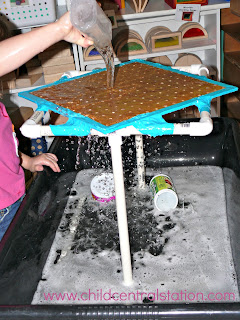Awhile back, I was once again inspired by
to build another amazing engaging contraption: a Pegboard Platform
This simple contraption is made with pegboard, pvc pipe and duct tape. It isn't exactly the same as the one that Tom built, but it serves the same purpose. During sensory table play- It gives the children another level to play- and all of the holes in the peg board cause whatever substance to fall through. Hours of great learning fun and exploration!
When we build contraptions like this- I tend to try to think about as many ways as possible to utilize them. You can change up the material in your sensory table- I bet this would be fabulous with sand- colored rice- I bet you could even squish play dough through it!
At the UP Early Childhood Conference, I put a big glop of flubber/slime on top of it and let it sit. The stringy ooze was fun to watch and provides a great visual! (Photo courtesy of Lisa Murphy aka The Ooey Gooey Lady)
Most of the slime came off- but some of it hardened in the holes of the apparatus. So... I thought- what could we put through those holes to open them back up?
Chenille Stems! (Pipe Cleaners!!!!!)
We didn't use the contraption in the table this time. Instead, I just placed it on the floor with our big bin of chenille stems/pipe cleaners.
It did not take long for one child to figure out how to put the stems through the holes.... and then another, and another.... until we had a whole group of children concentrating on adding stems to the work of art.
Some of the children worked hard to try to get the stems to fall straight through to the bottom while others worked to bend them to keep them in place.
Some of the children worked from the top-
Others thought it would be fun to work from the bottom.
Some of our younger friends had a hard time figuring out how to put the stems in.....
But they sure had fun pulling them out!











Comments